Luminescence Efficiency of Cadmium Tungstate (CdWO4) Single Crystal for Medical Imaging Applications
Abstract
1. Introduction
2. Materials and Methods
2.1. Output Luminescence Signal
2.2. Scintillator/Sensor Spectral Matching and Effective Luminescence Efficiency
2.3. Energy-Absorption Efficiency (EAE)
3. Results
4. Conclusions
Author Contributions
Funding
Conflicts of Interest
References
- Ziluei, H.; Azimirad, R.; Larijani, M.; Ziaie, F. Preparation and optimization of CdWO4-polymer nano-composite film as an alpha particle counter. Nucl. Instrum. Methods Phys. Res. A 2017, 852, 85–90. [Google Scholar] [CrossRef]
- Kroger, F. Some aspects of Luminescence of Solids; Elsevier Pub. Co.: Amsterdam, The Netherlands, 1948. [Google Scholar]
- Kobayashi, M.; Ishii, M.; Usuki, Y.; Yahagi, H. Cadmium tungstate scintillators with excellent radiation hardness and low background. Nucl. Instrum. Methods Phys. Res. A 1994, 349, 407–411. [Google Scholar] [CrossRef]
- Novais, S.; Da Silva, R.; Macedo, Z. Thermally stimulated luminescence of polycrystalline CdWO4 at low temperatures. J. Lumin. 2011, 131, 1283–1287. [Google Scholar] [CrossRef]
- Galashov, E.N.; Atuchin, V.V.; Kozhukhov, A.S.; Pokrovsky, L.D.; Shlegel, V.N. Growth of CdWO4 crystals by the low thermal gradient Czochralski technique and the properties of a (010) cleaved surface. J. Cryst. Growth. 2014, 401, 156–159. [Google Scholar] [CrossRef]
- Nagornaya, L.; Burachas, S.; Vostretsov, Y.; Martynov, V.; Ryzhikov, V. Studies of ways to reduce defects in CdWO4 single crystals. J. Cryst. Growth. 1999, 198/199, 877–880. [Google Scholar] [CrossRef]
- Sabharwal, S. Study of growth imperfections, optical absorption, thermoluminescence and radiation hardness of CdWO4 crystals. J. Cryst. Growth. 1999, 200, 191–198. [Google Scholar] [CrossRef]
- Ziluei, H.; Mojtahedzadeh, M.; Azimirad, L.; Ziaei, F. Fabrication of an alpha particle counter: Spin coated films of synthesized nanocrystalline cadmium tungstate powder. Int. J. Radiat. Res. 2017, 15, 425–430. [Google Scholar]
- Shang, H.; Bliss, M.; Heald, S.; Sham, T.; Heigl, F.; Cao, G. Dense and optical transparent CdWO4 films by sol-gel processing for scintillation applications. J. Mater. Res. 2007, 22, 1527–1536. [Google Scholar] [CrossRef]
- Sofronov, D.; Sofronova, E.; Starikov, V.; Baymer, V.; Kudin, K.; Matejchenko, P.; Mamalis, A.; Lavrynenko, S. Microwave Synthesis of Tetragonal Phase CdWO4. Mater. Manuf. Process. 2012, 27, 490–493. [Google Scholar] [CrossRef]
- Nazarenko, B.; Baumer, V.; Dolzhenkova, E.; Kosmyna, M. Structural Defects in Czochralski-Grown CdWO4 Single Crystals. Inorg. Mater. 2005, 41, 1114–1117. [Google Scholar] [CrossRef]
- Ruiz-Fuertes, J.; Friedrich, A.; Errandonea, D.; Segura, A.; Morgenroth, W.; Rodríguez-Hernández, P.; Muñoz, A.; Meng, Y. Optical and structural study of the pressure-induced phase transition of CdWO4. Phys. Rev. B 2017, 95, 174105. [Google Scholar] [CrossRef]
- Babamoradi, M.; Liyai, M.; Azimirad, R.; Salehi, H. Electronic structure and optical properties of the single crystal and two-dimensional structure of CdWO4 from first principles. Phys. B Condens. Matter. 2017, 511, 103–108. [Google Scholar] [CrossRef]
- Grigorjeva, L.; Deych, R.; Millers, D.; Chernova, S. Time-resolved luminescence and absorption in CdWO4. Radiat. Meas. 1998, 29, 267–271. [Google Scholar] [CrossRef]
- Lecoq, P.; Gektin, A.; Korzhik, M. Inorganic Scintillators for Detector Systems, Physical Principles and Crystal Engineering, 2nd ed.; Springer: Switcherland, 2017. [Google Scholar]
- Nagornaya, L.; Onyshchenko, G.; Pirogov, E.; Starzhinskiy, N.; Tupitsyna, I.; Ryzhikov, V.; Galich, Y.; Vostretsov, Y.; Galkin, S.; Voronkin, E. Production of the high-quality CdWO4 single crystals for application in CT and radiometric monitoring. Nucl. Instrum. Methods Phys. Res. A 2005, 537, 163–167. [Google Scholar] [CrossRef]
- Moszynski, M.; Balcerzyk, M.; Kapusta, M.; Syntfeld, A.; Wolski, D.; Pausch, G.; Stein, J.; Schotanus, P. CdWO4 crystal in gamma-ray spectrometry. IEEE Trans. Nucl. Sci. 2005, 52, 3124–3312. [Google Scholar] [CrossRef]
- Tupitsyna, I.; Grinyov, B.; Katrunov, K.; Nagornaya, L.; Onishchenko, G. Radiation Damage in CWO Scintillation Crystals with Different Defects. IEEE Trans. Nucl. Sci. 2009, 56, 2983–2988. [Google Scholar] [CrossRef]
- Lammers, M.; Blasse, G.; Roberts, D. The Luminescence of Cadmium Tungstate (CdWO4). Phys. Stat. Sol. A 1981, 63, 569–572. [Google Scholar] [CrossRef]
- Chirila, M.; Garces, N.; Murphy, H.; Wicks, C.; Grencewicz, K.; Halliburton, L.; Giles, N. Identification of trapping sites for OH− molecular ions in CdWO4. J. Phys. Chem. Solids. 2000, 61, 1871–1876. [Google Scholar] [CrossRef]
- Garces, N.; Chirila, M.; Murphy, H.; Foise, J.; Thomas, E.; Wicks, C.; Grencewicz, K.; Halliburton, L.; Giles, Ν. Absorption, luminescence, and electron paramagnetic resonance of molybdenum ions in CdWO4. J. Phys. Chem. Solids. 2003, 64, 1195–1200. [Google Scholar] [CrossRef]
- Xu, W.; Zheng, C.; Hua, H.; Yang, Q.; Chen, L.; Xi, Y.; Hu, C. Synthesis and photoelectrochemical properties of CdWO4 and CdS/CdWO4 nanostructures. Appl. Surf. Sci. 2015, 327, 140–148. [Google Scholar] [CrossRef]
- Eritenko, A.; Tsvetyansky, A. Separation of materials according to the effective atomic number using photons of two energies in the range of 60–700 keV. Nucl. Instrum. Meth. Phys. Res. B 2020, 462, 114–118. [Google Scholar] [CrossRef]
- Gupta, T. Radiation, Ionization, and Detection in Nuclear Medicine; Springer-Verlag: Berlin, Germany, 2013. [Google Scholar]
- Lecoq, P. Development of new scintillators for medical applications. Nucl. Instrum. Methods Phys. Res. A 2016, 809, 130–139. [Google Scholar] [CrossRef]
- Van Eijk, C. Inorganic scintillators in medical imaging. Phys. Med. Biol. 2002, 47, R85–R106. [Google Scholar] [CrossRef] [PubMed]
- Atuchin, V.; Galashov, E.; Khyzhun, O.; Bekenev, V.; Pokrovsky, L.; Borovlev, Y.; Zhdankov, V. Low Thermal Gradient Czochralski growth of large CdWO4 crystals and electronic properties of (010) cleaved surface. J. Solid State Chem. 2016, 236, 24–31. [Google Scholar] [CrossRef]
- Hosseinpour-Mashkani, S.; Sobhani-Nasab, A. A simple sonochemical synthesis and characterization of CdWO4 nanoparticles and its photocatalytic application. J. Mater. Sci. Mater. Electron. 2016, 27, 3240–3244. [Google Scholar] [CrossRef]
- Marsooli, M.; Fasihi-Ramandi, M.; Adib, K.; Pourmasoud, S.; Ahmadi, F.; Ganjali, M.; Sobhani Nasab, A.; Rahimi Nasrabadi, M.; Plonska-Brzezinska, M. Preparation and Characterization of Magnetic Fe3O4/CdWO4 and Fe3O4/CdWO4/PrVO4. Nanoparticles and Investigation of Their Photocatalytic and Anticancer Properties on PANC1 Cells. Materials 2019, 12, 3274. [Google Scholar] [CrossRef]
- Kosmyna, M.; Nazarenko, B.; Puzikov, V.; Shekhovtsov, A.; Ananenko, A.; Borodenko, Y.; Grinyov, B.; Koz’min, Y.; Tarasov, V. CdWO4 crystal growth and production of a spectrometric detection unit with a large-volume (V ≅ 350 cm3) crystal. Crystallogr. Rep. 2009, 54, 1265–1267. [Google Scholar] [CrossRef]
- Grigoriev, D.; Danevich, F.; Shlegel, V.; Vasiliev, Y. Development of crystal scintillators for calorimetry in high energy and astroparticle physics. J. Inst. 2014, 9, C09004. [Google Scholar] [CrossRef]
- Hojamberdiev, M.; Kanakala, R.; Ruzimuradov, O.; Yan, Y.; Zhu, G.; Xu, Y. Besom-like CdWO4 structures composed of single-crystalline nanorods grown under a simple hydrothermal process in ultra-wide pH range. Opt. Mater. 2012, 34, 1954–1957. [Google Scholar] [CrossRef]
- Rutherford, M.; Chapman, D.; White, T.; Drakopoulos, M.; Rack, A.; Eakins, D. Evaluating scintillator performance in time-resolved hard X-ray studies at synchrotron light sources. J. Synchrotron. Radiat. 2016, 23, 685–693. [Google Scholar] [CrossRef]
- Martz, H.; Glenn, S.; Smith, J.; Divin, C.; Azevedo, S. Poly- Versus Mono-Energetic Dual-Spectrum Non-Intrusive Inspection of Cargo Containers. IEEE Trans. Nucl. Sci. 2017, 64, 1709–1718. [Google Scholar] [CrossRef]
- Maddalena, F.; Tjahjana, L.; Xie, A.; Arramel, A.; Zeng, S.; Wang, H.; Coquet, P.; Drozdowski, W.; Dujardin, C.; Dang, C.; et al. Inorganic, Organic, and Perovskite Halides with Nanotechnology for High–Light Yield X- and γ-ray Scintillators. Crystals 2019, 9, 88. [Google Scholar] [CrossRef]
- Nagirnyi, V.; Feldbach, E.; Jönsson, L.; Kirm, M.; Kotlov, A.; Lushchik, A.; Nagornaya, L.; Savikhin, F.; Svensson, G. Study of oriented CdWO4 scintillating crystals using synchrotron radiation. Radiat. Meas. 2001, 33, 601–604. [Google Scholar] [CrossRef]
- Brik, M.; Nagirnyi, V.; Kirm, M. Ab-initio studies of the electronic and optical properties of ZnWO4 and CdWO4 single crystals. Mater. Chem. Phys. 2012, 134, 1113–1120. [Google Scholar] [CrossRef]
- Barabash, A.; Belli, P.; Bernabeib, R.; Borovlev, Y.; Cappella, F.; Caracciolo, V.; Cerulli, R.; Danevich, F.; Incicchitti, A.; Kobychev, V.; et al. Improvement of radiopurity level of enriched 116CdWO4 and ZnWO4 crystal scintillators by recrystallization. Nucl. Instrum. Methods Phys. Res. A 2016, 833, 77–81. [Google Scholar] [CrossRef]
- Grinyov, B.; Ryzhikov, V.; Lecoq, P.; Naydenov, S.; Opolonin, A.; Lisetskaya, E.; Galkin, S.; Shumeiko, N. Dual-energy radiography of bone tissues using ZnSe-based scintielectronic detectors. Nucl. Instrum. Methods Phys. Res. A 2007, 571, 399–403. [Google Scholar] [CrossRef]
- Barthe, N.; Braillon, P.; Ducassou, D.; Basse-Cathalinat, B. Comparison of two Hologic DXA systems (QDR 1000 and QDR 4500/A). Br. J. Radiol. 1997, 70, 728–739. [Google Scholar] [CrossRef]
- Panetta, D. Advances in X-ray detectors for clinical and preclinical Computed Tomography. Nucl. Instrum. Methods Phys. Res. A 2016, 809, 2–12. [Google Scholar] [CrossRef]
- Martini, N.; Koukou, V.; Michail, C.; Fountos, G. Dual Energy X-ray Methods for the Characterization, Quantification and Imaging of Calcification Minerals and Masses in Breast. Crystals 2020, 10, 198. [Google Scholar] [CrossRef]
- Popov, P.; Skrobov, S.; Zharikov, E.; Lis, D.; Subbotin, K.; Ivleva, L.; Shlegel, V.; Kosmyna, M.; Shekhovtsov, A. Investigation of the Thermal Conductivity of Tungstate Crystals. Crystallogr. Rep. 2018, 63, 111–116. [Google Scholar] [CrossRef]
- Advatech, U.K. Advatech-Radiation Detection/Imaging and Photonics. Available online: https://www.advatech-uk.co.uk/index.html (accessed on 20 March 2020).
- Advatech, U.K. CdWO4/CWO - Cadmium Tungstate. Available online: https://www.advatech-uk.co.uk/cdwo4.html (accessed on 20 March 2020).
- Michail, C.; Kalyvas, N.; Bakas, A.; Ninos, K.; Sianoudis, I.; Fountos, G.; Kandarakis, I.; Panayiotakis, G.; Valais, I. Absolute Luminescence Efficiency of Europium-Doped Calcium Fluoride (CaF2:Eu) Single Crystals under X-ray Excitation. Crystals 2019, 9, 234. [Google Scholar] [CrossRef]
- Michail, C.; Ninos, K.; Kalyvas, N.; Bakas, A.; Saatsakis, G.; Fountos, G.; Sianoudis, I.; Panayiotakis, G.; Kandarakis, I.; Valais, I. Spectral Efficiency of Lutetium Aluminum Garnet (Lu3Al5O12:Ce) with Microelectronic Optical Sensors. Microelectron. Reliab. 2020, 109, 113658. [Google Scholar] [CrossRef]
- Michail, C.; Valais, I.; Martini, N.; Koukou, V.; Kalyvas, N.; Bakas, A.; Kandarakis, I.; Fountos, G. Determination of the Detective Quantum Efficiency (DQE) of CMOS/CsI Imaging Detectors following the novel IEC 62220-1-1:2015 International Standard. Radiat. Meas. 2016, 94, 8–17. [Google Scholar] [CrossRef]
- Valais, I.; Kandarakis, I.; Nikolopoulos, D.; Sianoudis, I.; Dimitropoulos, N.; Cavouras, D.; Nomicos, C.; Panayiotakis, G. Luminescence efficiency of Gd2SiO5:Ce scintillator under x-ray excitation. IEEE Trans. Nucl. Sci. 2005, 52, 1830–1835. [Google Scholar] [CrossRef]
- Saatsakis, G.; Kalyvas, N.; Michail, C.; Ninos, K.; Bakas, A.; Fountzoula, C.; Sianoudis, I.; Karpetas, G.E.; Fountos, G.; Kandarakis, I.; et al. Optical Characteristics of ZnCulnS/ZnS (Core/Shell) Nanocrystal Flexible Films Under X-ray Excitation. Crystals 2019, 9, 343. [Google Scholar] [CrossRef]
- Michail, C.; Valais, I.; Fountos, G.; Bakas, A.; Fountzoula, C.; Kalyvas, N.; Karabotsos, A.; Sianoudis, I.; Kandarakis, I. Luminescence Efficiency of Calcium Tungstate (CaWO4) under X-ray radiation: Comparison with Gd2O2S:Tb. Measurement 2018, 120, 213–220. [Google Scholar] [CrossRef]
- Boone, J. X-ray production, interaction, and detection in diagnostic imaging. In Handbook of Medical Imaging: Physics and Psychophysics; Beutel, J., Kundel, H., Van Metter, R., Eds.; SPIE: Bellingham, WA, USA, 2000; Volume 1, pp. 36–57. [Google Scholar]
- Hamamatsu Photonics, MPPC (Multi-Pixel Photon Counters). Available online: http://www.hamamatsu.com/us/en/product/category/3100/4004/4113/index.html# (accessed on 23 January 2020).
- SensL, Silicon Photomultiplier. Available online: https://www.onsemi.cn/PowerSolutions/resolveTaxonomy.do?url=/products/sensors/silicon-photomultipliers-sipm (accessed on 23 January 2020).
- Rowlands, J.A.; Yorkston, J. Flat Panel Detectors for Digital Radiography. In Handbook of Medical Imaging Physics and Psychophysics; Beutel, J., Kundel, H., Van Metter, R., Eds.; SPIE: Bellingham, WA, USA, 2000; Volume 1, pp. 223–328. ISBN 9780819477729. [Google Scholar]
- Magnan, P. Detection of visible photons in CCD and CMOS: A comparative view. Nucl. Instrum. Methods Phys. Res. A 2003, 504, 199–212. [Google Scholar] [CrossRef]
- Hubbell, J.; Seltzer, S. Tables of X-ray Mass Attenuation Coefficients and Mass Energy Absorption Coefficients 1 to 20 MeV for Elements Z = 1 to 92 and 48 Additional Substances of Dosimetric interest; NISTIR 5632; US Department of Commerce: Gaithersburg, MD, USA, 1995. [Google Scholar]
- Storm, E.; Israel, H. Report LA-3753; Los Alamos Scientific Laboratory, University of California: Berkeley, CA, USA, 1967. [Google Scholar]
- Evans, R.D. The Atomic Nucleus; McGraw-Hill: New York, NY, USA, 1955. [Google Scholar]
- Seibert, J.; Boone, J. X-ray imaging physics for nuclear medicine technologists. Part 2: X-ray interactions and image formation. J. Nucl. Med. Technol. 2005, 33, 3–18. [Google Scholar]
- Lina, L.; Leitnera, D.; Benattia, C.; Perdikakis, G.; Krausea, S.; Rencsoka, R.; Nasha, S.; Wittmer, W. Investigation of ion induced damage in KBr, YAG:Ce, CaF2:Eu and CsI:Tl irradiated by various-energy protons. J. Inst. 2015, 10, P03024. [Google Scholar] [CrossRef]
- Rzhevskaya, O.; Spasskii, D.; Kolobanov, V.; Mikhaœlin, V.; Nagornaya, L.; Tupitsina, I.; Zadneprovskii, B. Optical and Luminescence Properties of CdWO4 and CdWO4:Mo Single Crystals. Opt. Spectroscop. 2008, 104, 366–373. [Google Scholar] [CrossRef]
- Lee, K.; Natsui, T.; Hirai, S.; Uesaka, M.; Hashimoto, E. Application of X-Band Linac for Material Recognition with two Fold Scintillator Detector. In Proceedings of the Linear Accelerator Conference LINAC2010, Tsukuba, Japan, 12–17 September 2010; pp. 124–126. [Google Scholar]
- Juste, B.; Morera, D.; Miró, R.; Verdú, G. Calculation of energetic dual-energy detector efficiency using MCNP and GEANT Monte Carlo codes. In Proceedings of the 2nd International Conference on Advancements in Nuclear Instrumentation, Measurement Methods and their Applications, Ghent, Belgium, 6–9 June 2011; pp. 1–4. [Google Scholar]
- Grinyov, Β.; Ryzhikov, V.; Naydenov, S.; Opolonin, A.; Lisetskaya, E.; Galkin, S.; Lecoq, P. Medical dual-energy imaging of bone tissues using ZnSe-based scintillator-photodiode detectors. 2006 IEEE Nucl. Sci. Symp. Conf. Rec. 2006, 3, 1945–1949. [Google Scholar]
- Koukou, V.; Martini, N.; Fountos, G.; Michail, C.; Sotiropoulou, P.; Bakas, A.; Kalyvas, N.; Kandarakis, I.; Speller, R.; Nikiforidis, G. Dual energy subtraction method for breast calcification imaging. Nucl. Instrum. Methods Phys. Res. A 2017, 848, 31–38. [Google Scholar] [CrossRef]
- Koukou, V.; Martini, N.; Fountos, G.; Michail, C.; Bakas, A.; Oikonomou, G.; Kandarakis, I.; Nikiforidis, G. Application of a dual energy X-ray imaging method on breast specimen. Result. Phys. 2017, 7, 1634–1636. [Google Scholar] [CrossRef]
- Martini, N.; Koukou, V.; Fountos, G.; Michail, C.; Bakas, A.; Kandarakis, I.; Speller, R.; Nikiforidis, G. Characterization of breast calcification types using dual energy x-ray method. Phys. Med. Biol. 2017, 62, 7741–7764. [Google Scholar] [CrossRef] [PubMed]
- Martini, N.; Koukou, V.; Michail, C.; Sotiropoulou, P.; Kalyvas, N.; Kandarakis, I.; Nikiforidis, G.; Fountos, G. Pencil beam spectral measurements of Ce, Ho, Yb and Ba powders for potential use in Medical applications. J. Spectrosc. 2015, 2015, 563763. [Google Scholar] [CrossRef]
- Yeh, B.; Shepherd, J.; Wang, Z.; Teh, H.; Hartman, R.; Prevrhal, S. Dual Energy and Low KVp CT in the Abdomen. Am. J. Roentgenol. 2009, 193, 47–54. [Google Scholar] [CrossRef]
- Goodsitt, M.; Christodoulou, E.; Larson, S. Accuracies of the synthesized monochromatic CT numbers and effective atomic numbers obtained with a rapid kVp switching dual energy CT scanner. Med. Phys. 2011, 38, 2222–2232. [Google Scholar] [CrossRef]
- Coursey, C.; Nelson, R.; Boll, D.; Paulson, E.; Ho, L.; Neville, A.; Marin, D.; Gupta, R.; Schindera, S. Dual-Energy Multidetector CT: How Does It Work, What Can It Tell Us, and When Can We Use It in Abdominopelvic Imaging? RadioGraphics 2010, 30, 1037–1055. [Google Scholar] [CrossRef]
- Aichinger, H.; Dierker, J.; Joite-Barfuß, S.; Säbel, M. Radiation Exposure and Image Quality in X-ray Diagnostic Radiology, Physical Principles and Clinical Applications, 2nd ed.; Springer-Verlag: Berlin/Heidelberg, Germany, 2012; ISBN 987-3-642-11240-9. [Google Scholar]
- Manji, F.; Wang, J.; Norman, G.; Wang, Z.; Koff, D. Comparison of dual energy subtraction chest radiography and traditional chest X-rays in the detection of pulmonary nodules. Quant. Imaging Med. Surg. 2016, 6, 1–5. [Google Scholar]
- Shkumat, N.A.; Siewerdsen, J.H.; Dhanantwari, A.C.; Williams, D.B.; Richard, S.; Paul, N.S.; Yorkston, J.; Van Metter, R. Optimization of image acquisition techniques for dual-energy imaging of the chest. Med. Phys. 2007, 34, 3904–3915. [Google Scholar] [CrossRef]
- Lee, Μ.; Lee, D.; Kim, H.; Choi, S.; Kim, D.; Kim, H.J. Development of a non-linear dual-energy technique in chest radiography. Radiat. Phys. Chem. 2020, 172, 108811. [Google Scholar] [CrossRef]
- Zhang, C.; Sang, Z.; Wang, X.; Zhang, X.; Yang, Y. The effects of inter-crystal scattering events on the performance of PET detectors. Phys. Med. Biol. 2019, 64, 205004. [Google Scholar] [CrossRef] [PubMed]
- Fritz, S.; Cook, L. High-resolution digital x-ray detector utilizing a discrete array of CdWO4 scintillators and a self-scanned photodiode array. Med. Phys. 1987, 14, 244–248. [Google Scholar] [CrossRef] [PubMed]
- Luhta, R.; Mattson, R.; Taneja, N.; Bui, P.; Vasbo, R. Back-illuminated photodiodes for multislice CT. In Proceedings of the SPIE 5030, Medical Imaging 2003: Physics of Medical Imaging, San Diego, CA, USA, 5 June 2003. [Google Scholar] [CrossRef]

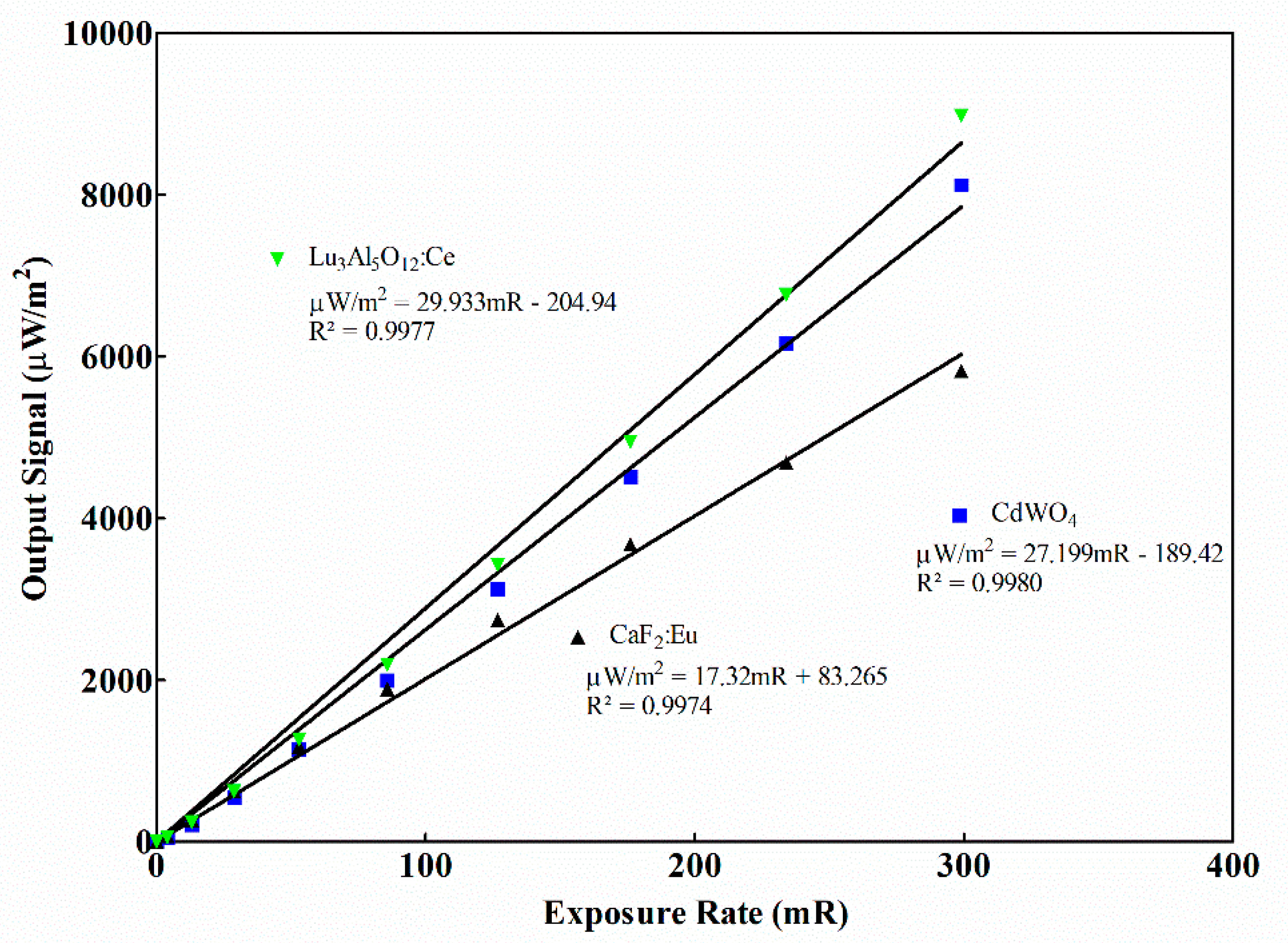
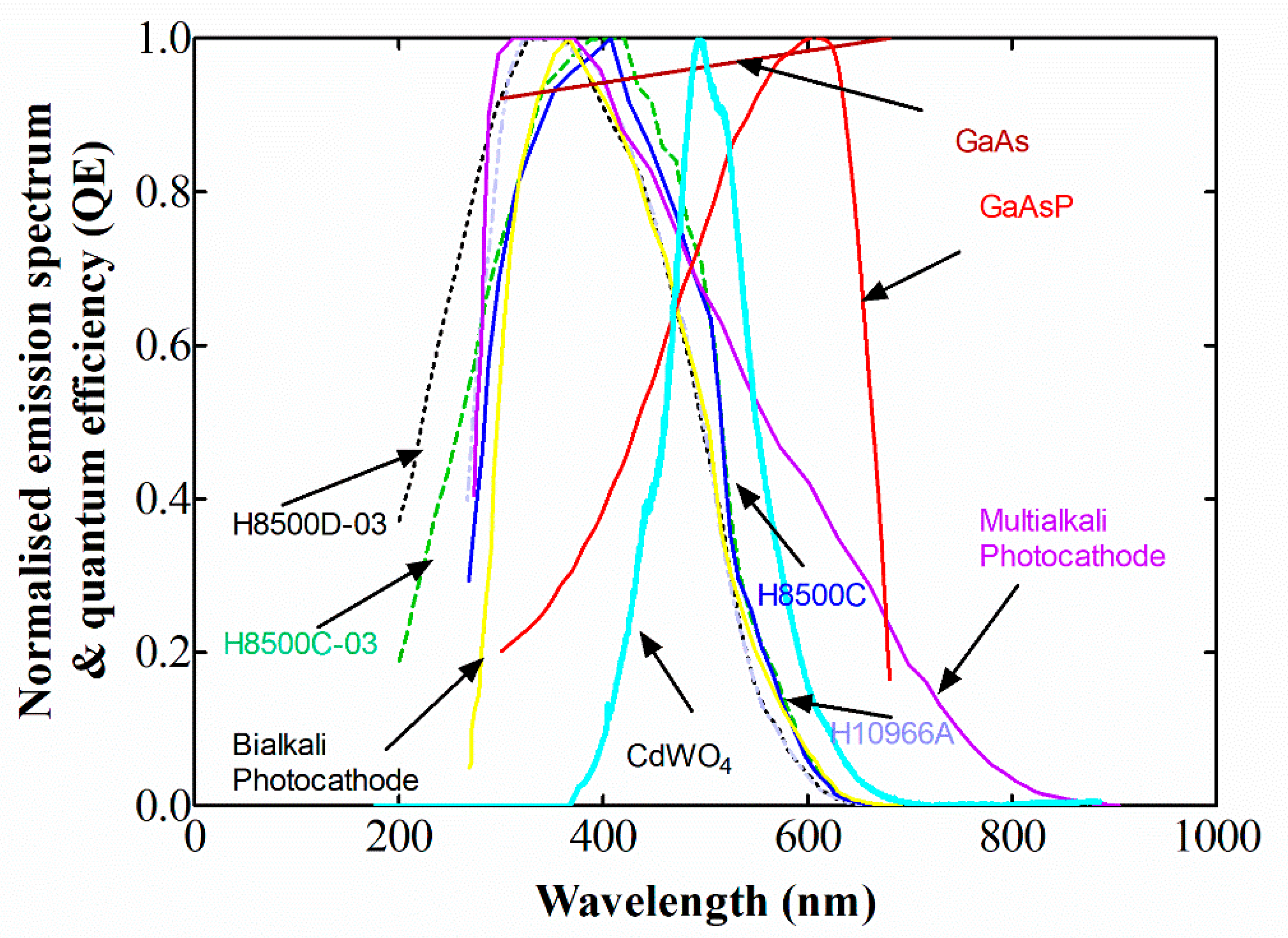

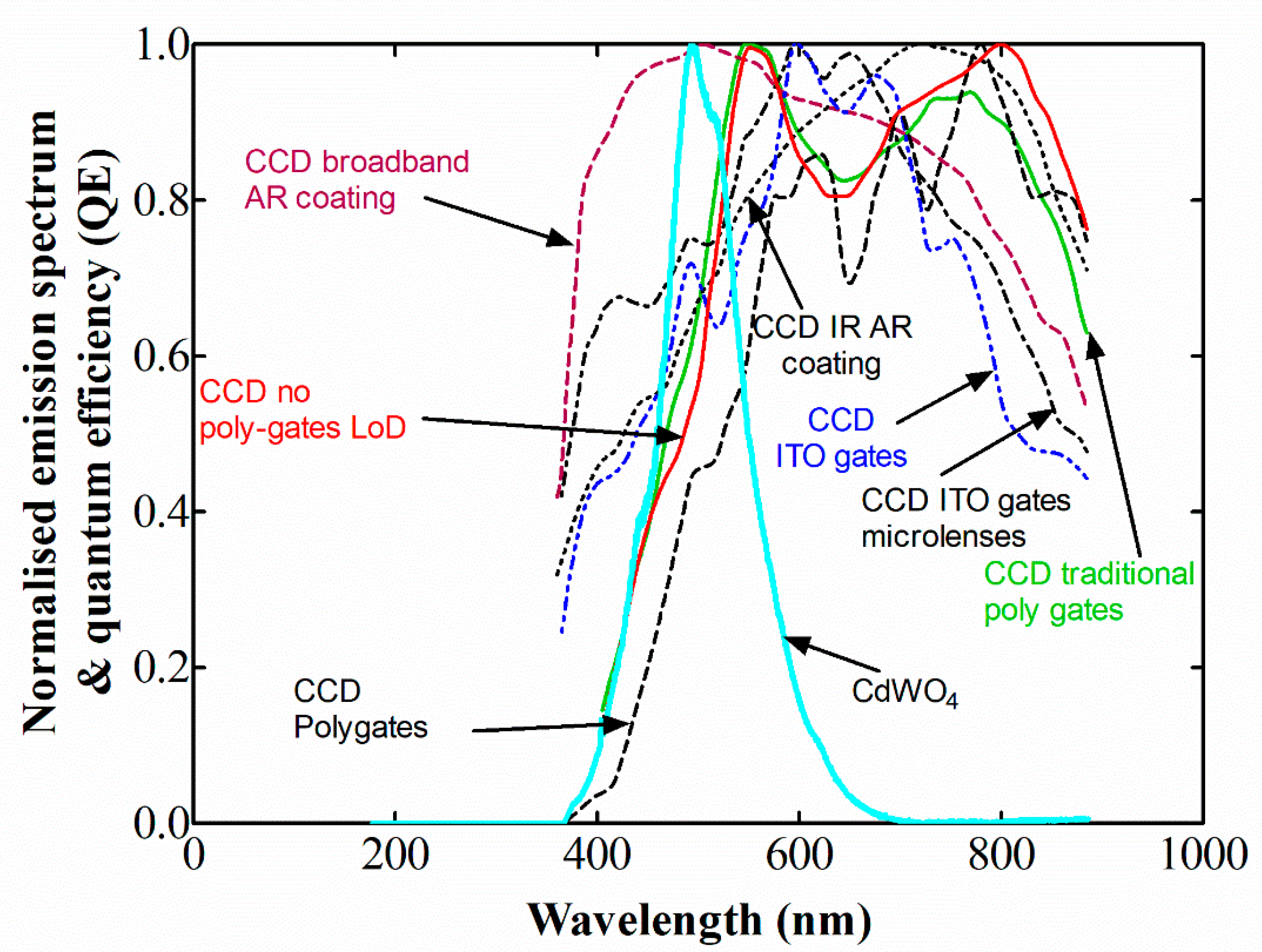
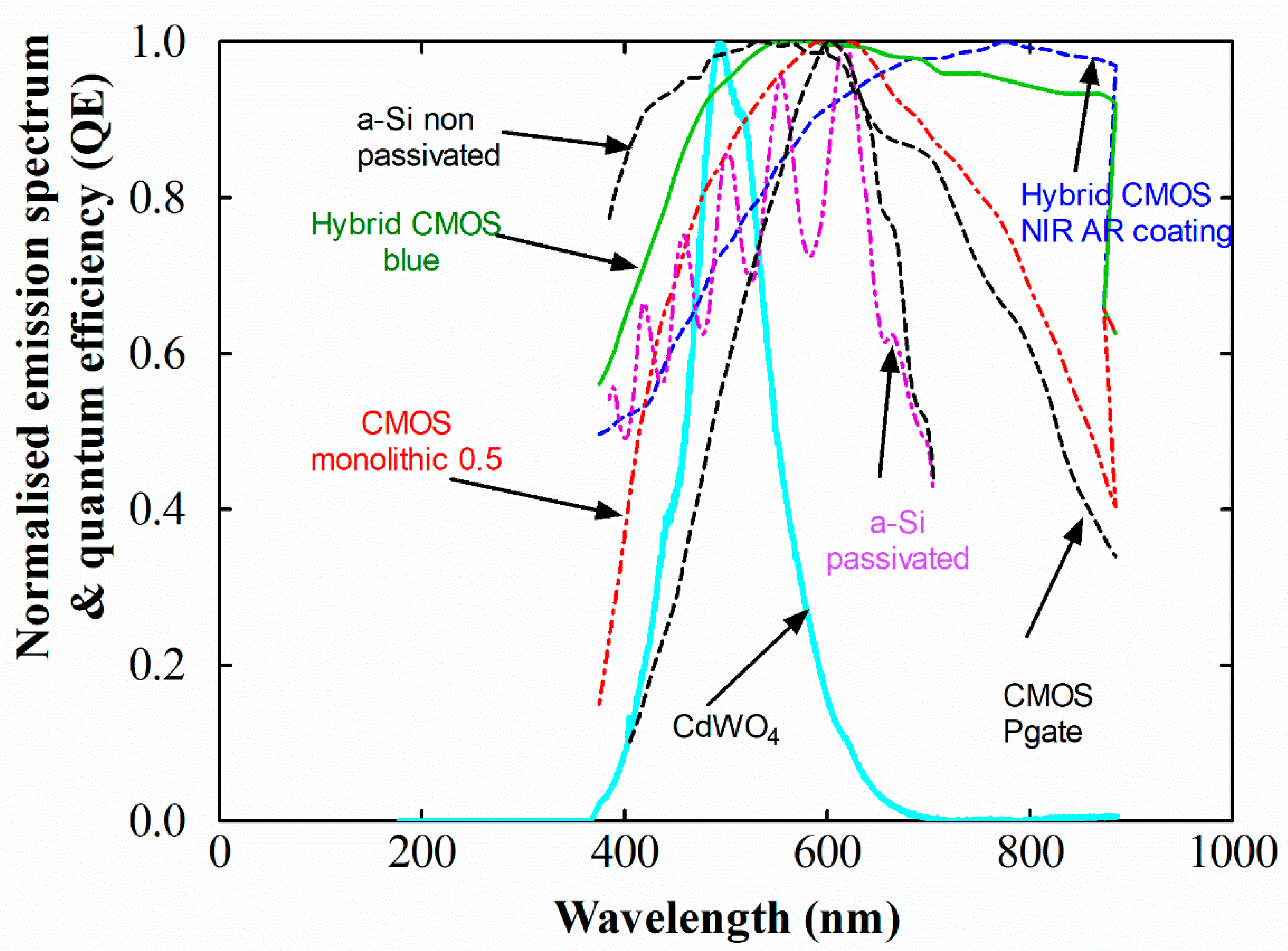
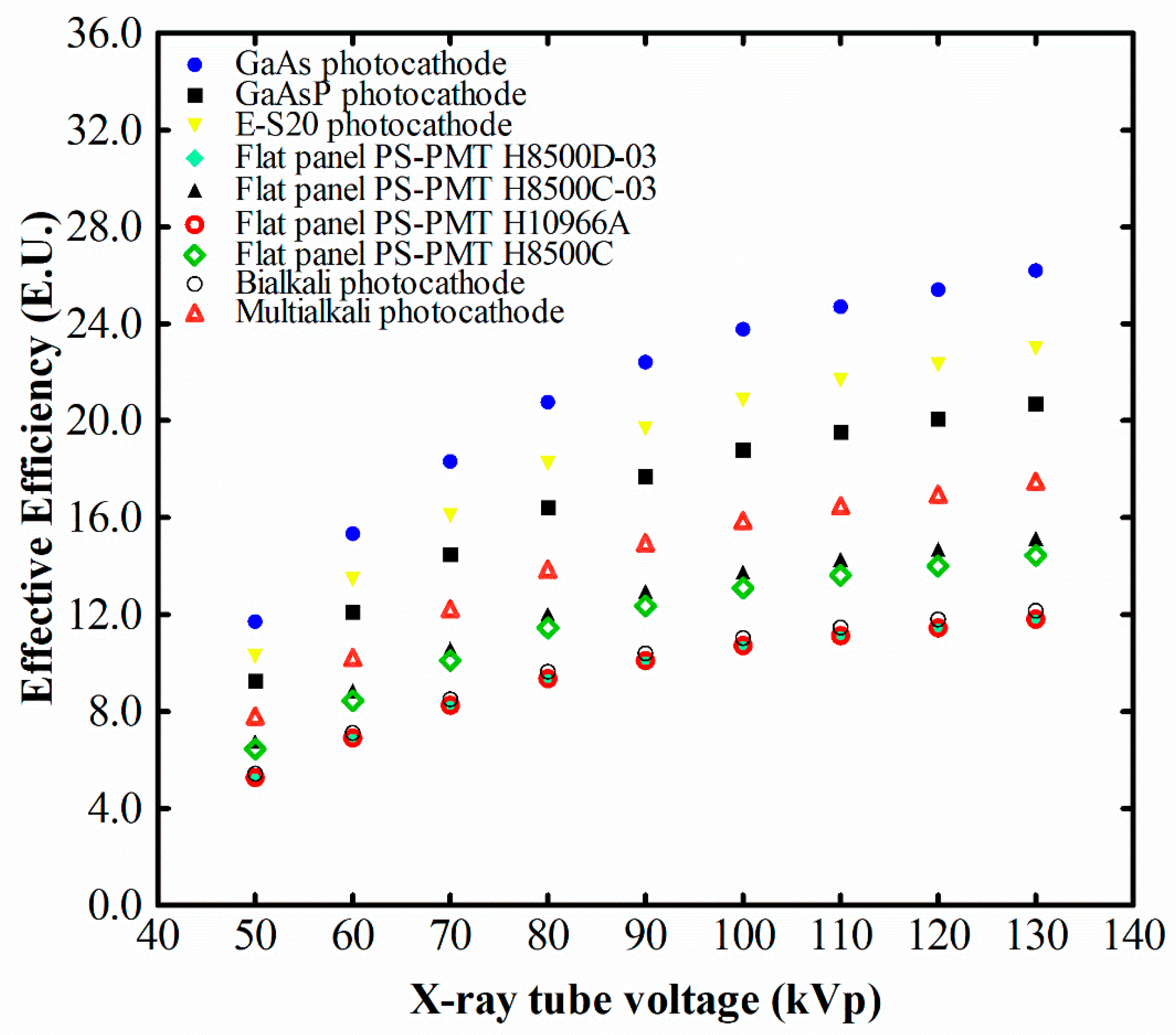

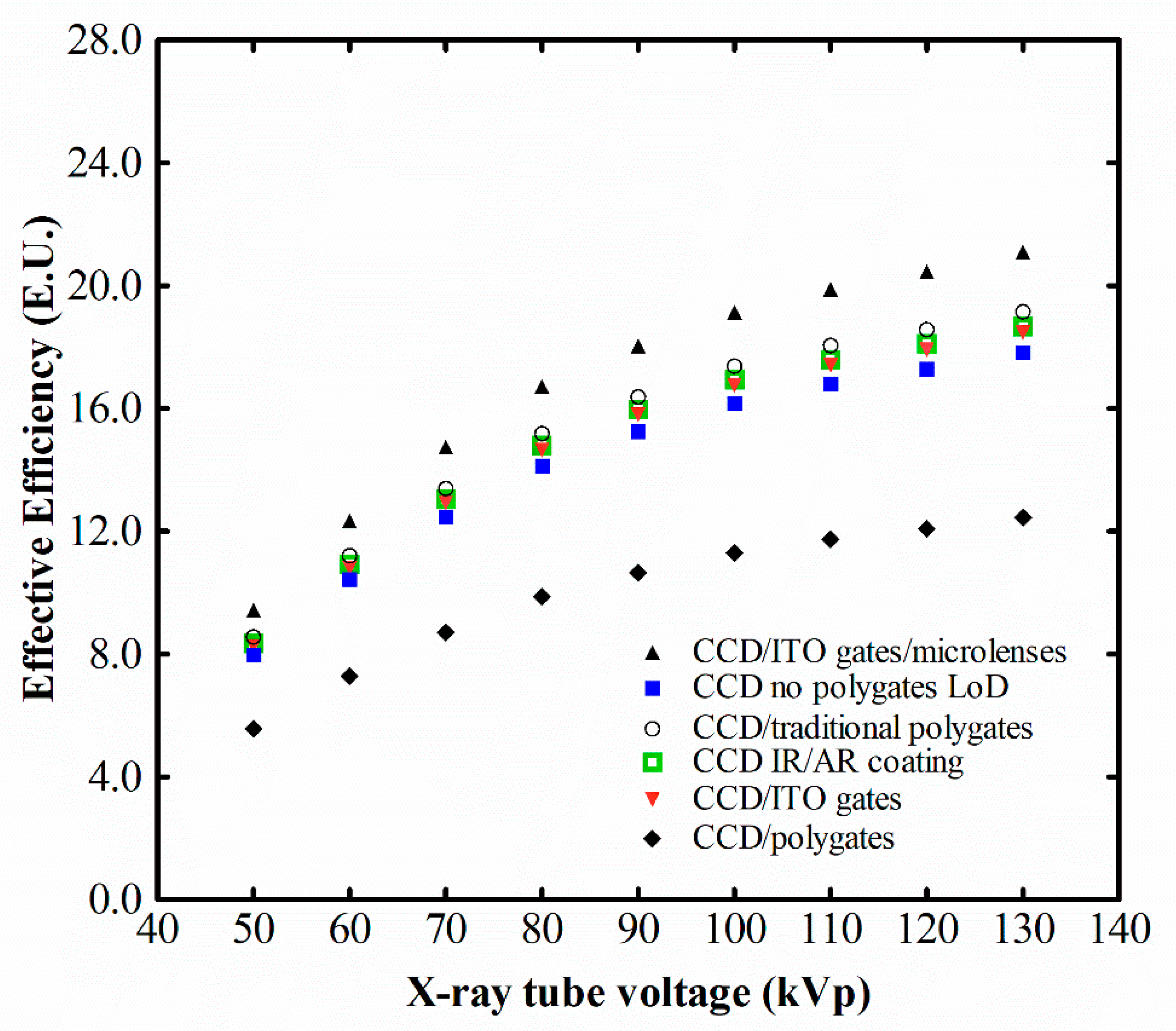
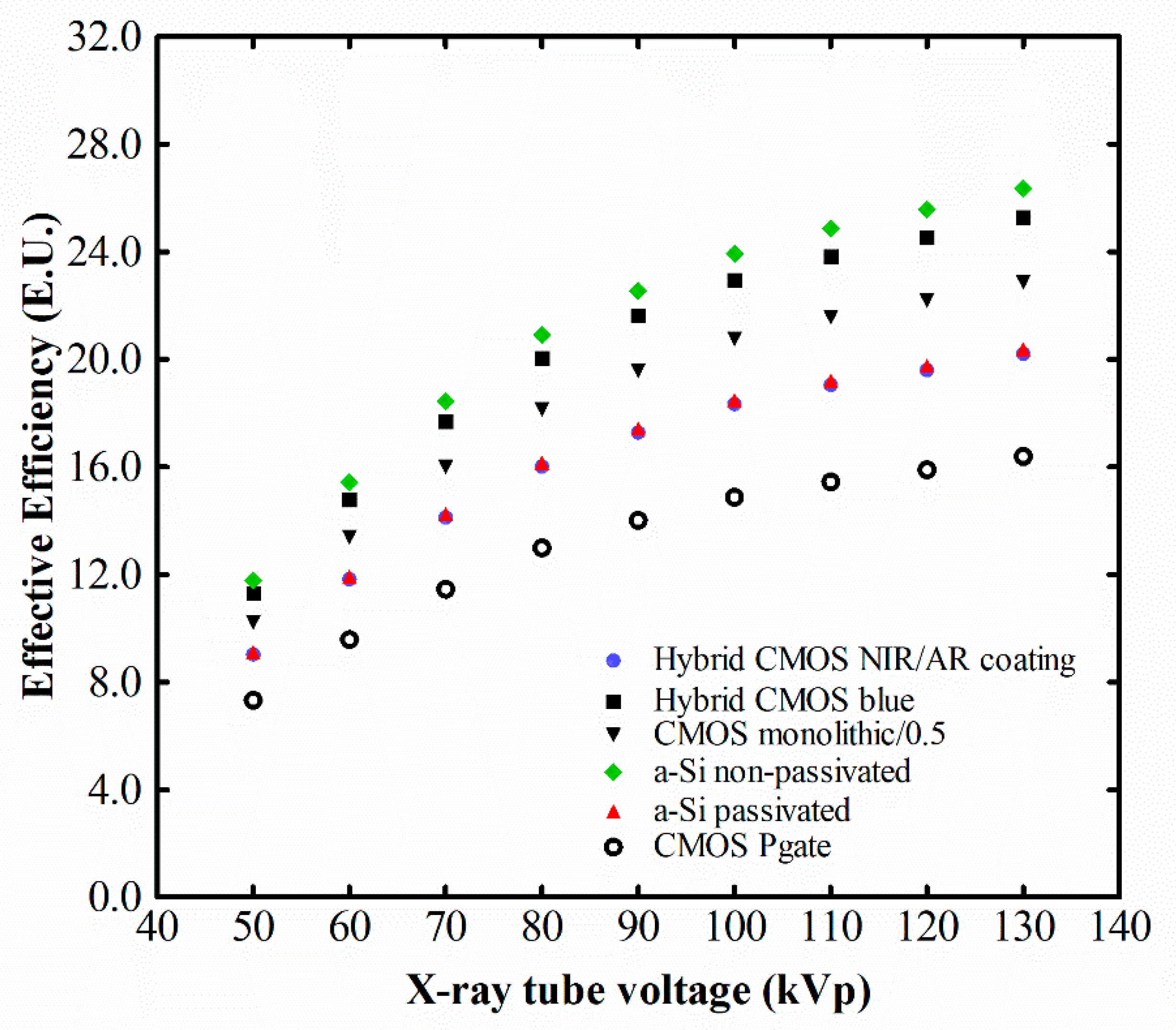


| Properties | CdWO4 | CaF2:Eu | Lu3Al5O12:Ce |
|---|---|---|---|
| Wavelength (Max. Emission—nm) | 490 | 435 | 535 |
| Wavelength Range (nm) | 380–800 | 395–525 | 475–800 |
| Decay Time (ns) | 5000 | 950 | 70 |
| Light-Yield (photons/MeV) | 6200–28,000 | 13,000–30,000 | 16,000–27,000 |
| Photoelectron Yield (% of NaI(Tl)) | 30–50 | 50 | 20 |
| Radiation-Length (cm) | 1.06 | 3.05 | 1.3 |
| Refractive Index | 2.2–2.3 (@max nm) | 1.47 (@435 nm) | 1.84 (@633 nm) |
| Density (g/cm³) | 7.9 | 3.18 | 6.73 |
| Atomic Number (Effective) | 61–66 | 16.5 | 62.9 |
| Melting Point (oK) | 1325 | 1360 | 2020 |
| Coefficient of Thermal Expansion (1/C) | 10.2 × 10−⁶ | 19.5 × 10−⁶ | 8.8 × 10−⁶ |
| Conductivity (Thermal, W/mK) | 4.69(@300K) | 9.7 | 9.6 |
| Hardness (Mohs) | 4–4.5 | 4 | 8.5 |
| Hygroscopic | No | No | No |
| Optical Detectors | CdWO4 | Optical Detectors | CdWO4 |
|---|---|---|---|
| CCD broadband anti reflective coating | 0.97 | Photocathode GaAsP | 0.76 |
| CCD infrared anti-reflection coating | 0.69 | Photocathode E-S20 | 0.85 |
| CMOS hybrid with blue anti-reflection coating | 0.74 | Si-PM MicroFC30035SMT | 0.72 |
| Hybrid CMOS blue emission | 0.93 | Si-PM MicroFB30035SMT | 0.66 |
| CMOS (monolithic 0.25 μm) | 0.84 | Si-PM MicroFM10035 | 0.88 |
| passivated a-Si:H | 0.75 | Si-PM S10985050C | 0.87 |
| non-passivated a-Si:H | 0.97 | Si-PM S1036211025U | 0.85 |
| CCD with indium tin oxide gates and microlenses | 0.78 | Si-PM S1036211050U | 0.87 |
| CCD with indium tin oxide gates | 0.68 | Si-PM S1036211100U | 0.86 |
| CCD poly-gates | 0.46 | PS-PMT Flat panel H8500C03 | 0.56 |
| CCD no poly-gates | 0.66 | PS-PMT Flat panel H8500D03 | 0.43 |
| CCD traditional poly-gates | 0.70 | PS-PMT Flat panel H10966A | 0.43 |
| CMOS (photo-gate array) | 0.60 | PS-PMT Flat panel H8500C | 0.53 |
| CMOS Rad-Eye high resolution | 0.82 | Photocathode Bi-alkali | 0.45 |
| GaAs Photocathode | 0.96 | Photocathode Multi-alkali | 0.64 |
© 2020 by the authors. Licensee MDPI, Basel, Switzerland. This article is an open access article distributed under the terms and conditions of the Creative Commons Attribution (CC BY) license (http://creativecommons.org/licenses/by/4.0/).
Share and Cite
Michail, C.; Koukou, V.; Martini, N.; Saatsakis, G.; Kalyvas, N.; Bakas, A.; Kandarakis, I.; Fountos, G.; Panayiotakis, G.; Valais, I. Luminescence Efficiency of Cadmium Tungstate (CdWO4) Single Crystal for Medical Imaging Applications. Crystals 2020, 10, 429. https://doi.org/10.3390/cryst10060429
Michail C, Koukou V, Martini N, Saatsakis G, Kalyvas N, Bakas A, Kandarakis I, Fountos G, Panayiotakis G, Valais I. Luminescence Efficiency of Cadmium Tungstate (CdWO4) Single Crystal for Medical Imaging Applications. Crystals. 2020; 10(6):429. https://doi.org/10.3390/cryst10060429
Chicago/Turabian StyleMichail, Christos, Vaia Koukou, Niki Martini, George Saatsakis, Nektarios Kalyvas, Athanasios Bakas, Ioannis Kandarakis, George Fountos, George Panayiotakis, and Ioannis Valais. 2020. "Luminescence Efficiency of Cadmium Tungstate (CdWO4) Single Crystal for Medical Imaging Applications" Crystals 10, no. 6: 429. https://doi.org/10.3390/cryst10060429
APA StyleMichail, C., Koukou, V., Martini, N., Saatsakis, G., Kalyvas, N., Bakas, A., Kandarakis, I., Fountos, G., Panayiotakis, G., & Valais, I. (2020). Luminescence Efficiency of Cadmium Tungstate (CdWO4) Single Crystal for Medical Imaging Applications. Crystals, 10(6), 429. https://doi.org/10.3390/cryst10060429









